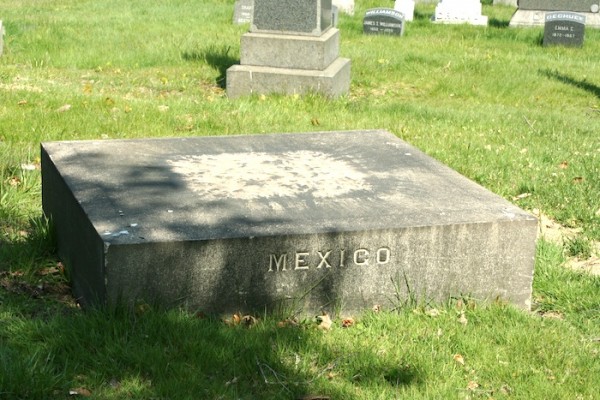It was not business-as-usual in New York City on July 12, 1848. The remains of the officers of New York’s First Regiment who had died in the far-off Mexican-American War had finally come home.
On that date, respects had been paid to them as their caskets were displayed in front of City Hall–the crowd had numbered 20,000. Speeches were given, the procession route was cleared, church and fire bells rang, businesses closed, and flags were lowered to half-mast from sunrise to sunset. Militia units, clergy, mourners and relatives, as well as office-holders and “citizens and strangers,” would now accompany them for the last leg of their journey–to their final resting place at Green-Wood Cemetery. There, prayers were said and salutes were fired. And, on the next day, July 13, they would be interred in a lot that had been donated by Green-Wood for their burial.

It had not been an easy journey. These officers of New York State’s Militia had gone off to war with Mexico with great hopes. They had come home in lead coffins. And even that had not been easy. They had been buried in Mexico where they fell: Lieutenant Colonel Charles Baxter (for whom Baxter Street in Manhattan would soon be named) was wounded storming Chapultepec and died in Mexico City, Captain James Barclay died in San Angelo of exposure, Lieutenant Charles Gallagher died of sickness near Mexico City, and Lieutenant Edgar Chandler was mortally wounded at Churubusco.
New York City’s Common Council (the equivalent of today’s City Council) had deputized Lieutenant Alexander Forbes to go to Mexico and retrieve their remains. Forbes had done his job well–he located their graves, dug up their remains, and headed back towards New York with them. But he didn’t get very far; fever caught up with him in New Orleans, and he died on June 22, 1848. Lieutenant Robert Floyd stepped into the breach; he assumed responsibility for the bodies, now with Forbes’s body added, and brought them by steamboat and railroad to New York. They came through Buffalo and down the Hudson, arriving on July 4, Independence Day.
Five bodies were brought to Green-Wood on July 12. The Baxter Blues, Company H of the 12th New York Regiment, fired three volleys and offered a parting salute. The next day these remains were joined by those of Captain Charles H. Pearson. And soon they were joined by Lieutenant John Kline, who had lived in Brooklyn but served with the Louisiana Rangers and was killed in Mexico near National Bridge. Three years later, Lieutenant Robert Floyd, who had brought the bodies back from New Orleans, and had died in Panama in 1849 of fever, was himself interred in that lot. Still later, in the 1860s, Captain Morton Fairchild and Private Alfred Lombard also were interred there. In all, 10 bodies lie in the Mexico Lot. They are buried in cruciform around the granite base: three on its front side, three at its back, two to the left and two to the right.
After the men were interred, the First Regiment agreed to mark their graves, fence the lot, and erect a suitable monument. But little of that was ever done. As of 1875, only wooden boards marked their graves. In 1901, The New York Times wrote about the sad condition of the lot. And, all that has been out there, all of these years, is the base for an obelisk that was never commissioned.
For an earlier blog post about this lot, and its rediscovery–how I learned about it–click here.
So, next Friday, on July 13, we will do the right thing. When we walk out to the final resting place of these officers, who made the ultimate sacrifice in the service of their country, an Armed Forces color guard will lead the way as a drummer beats the cadence. Ten bronze plaques, mounted on granite, will be unveiled to mark the graves of the men buried in that lot. A bugler will play “Taps”–which has an interesting association with this lot. The man who wrote “Taps”–Civil War General Daniel Butterfield–wrote to Green-Wood in 1888, in his capacity as president of the Old Guard Association of the 12th Regiment, asking about the Mexico Lot, in the hopes that a suitable memorial might some day be erected there.
Finally, after 164 years in Green-Wood’s ground, these men will lie in marked graves.
Please join us to pay your respects to these men. This event, “No Longer Forgotten: Honoring Officers From The Mexican-American War,” will begin with a walk from Green-Wood’s Main Gates to the nearby Mexico Lot at 10:00 a.m. For more information on this event, click here.